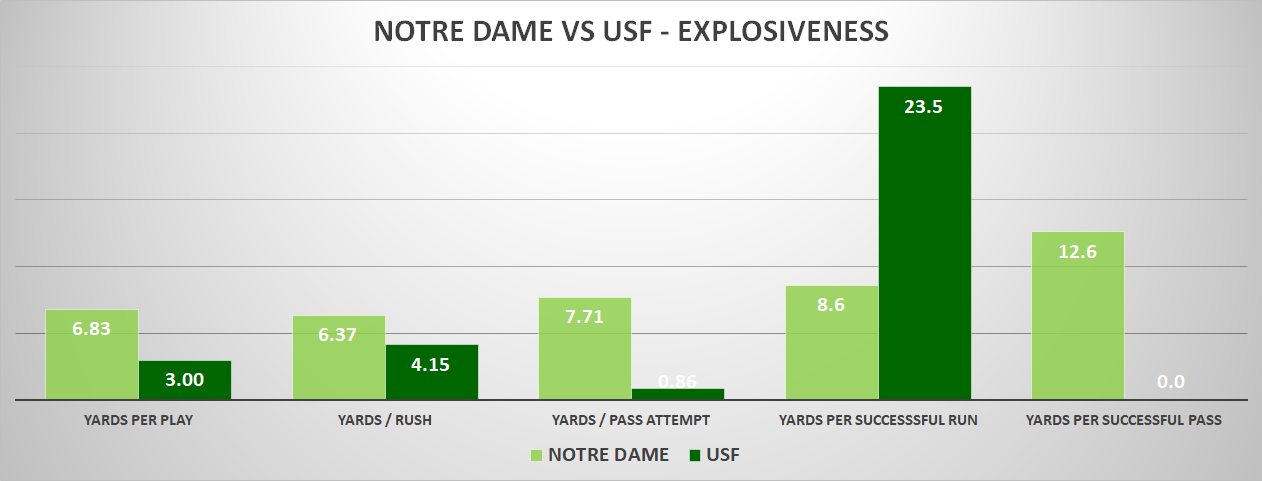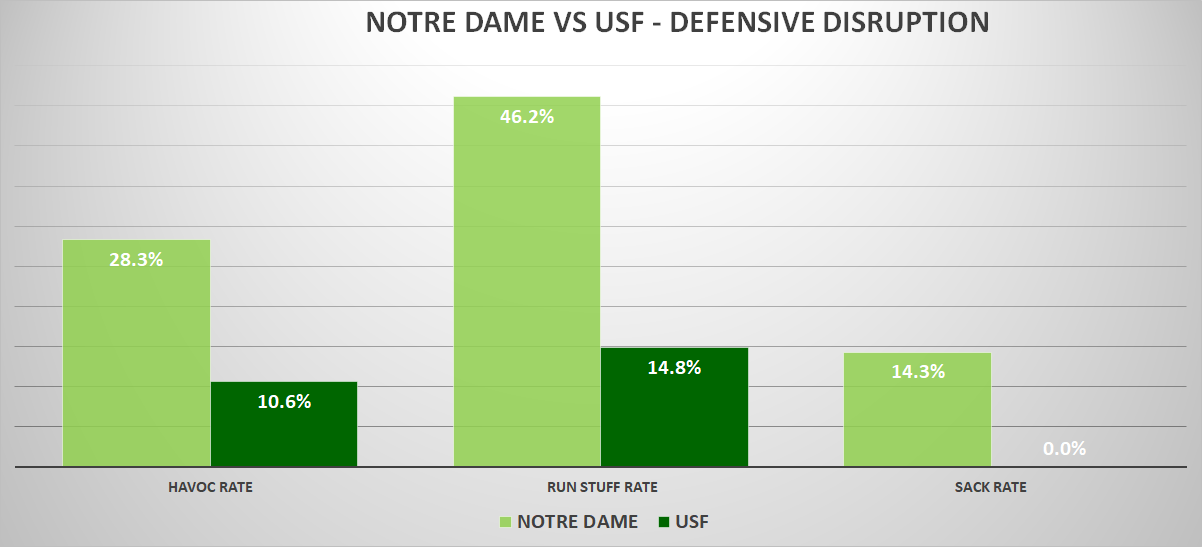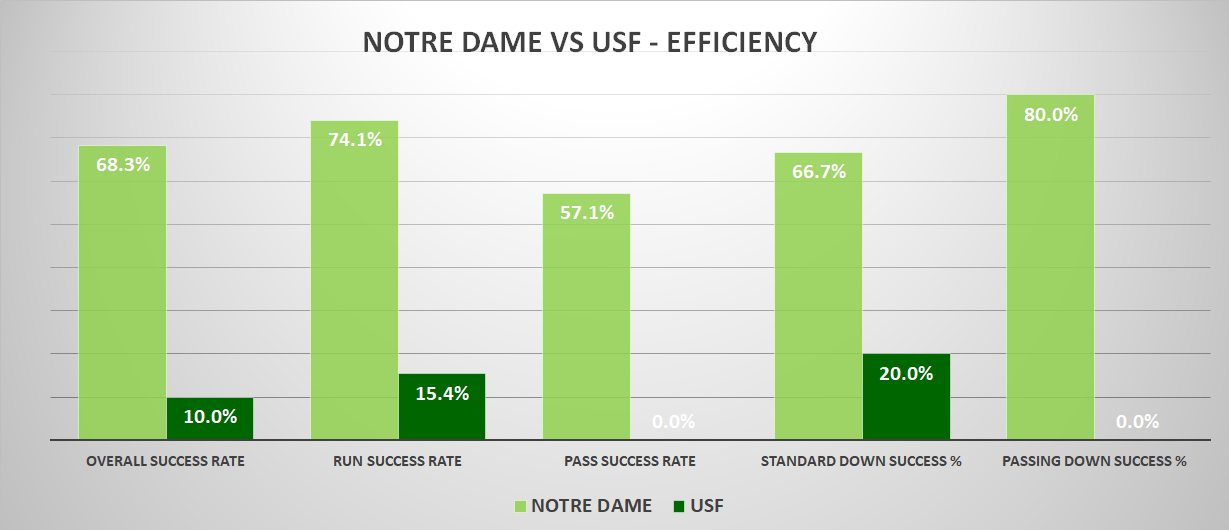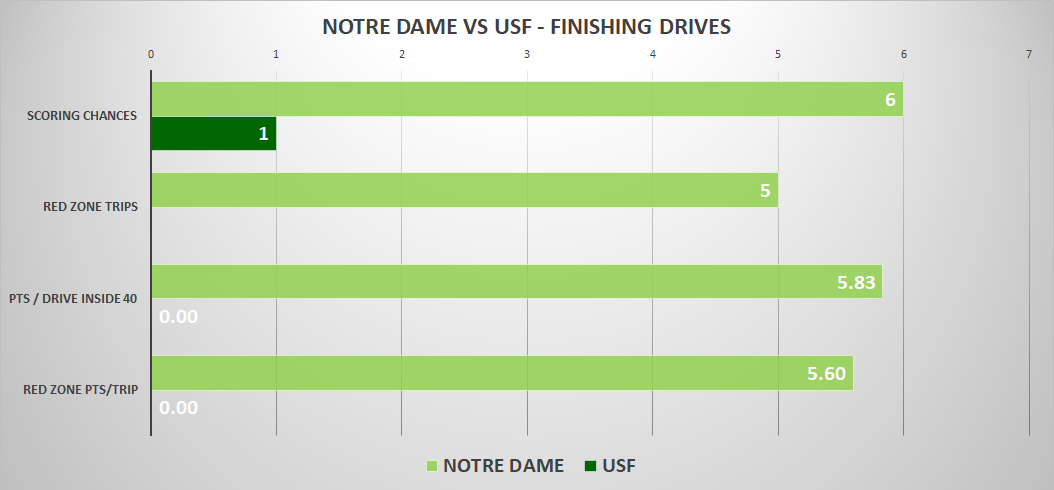The dominant win over USF featured an efficiency massacre, defensive disruption from unlikely sources, and a nearly 30-yard per possession field position advantage for Notre Dame. This game reached garbage time at the half, and the Bulls failed to convert a single successful play through the air or on a passing down.
Confused? Check out this handy advanced stats glossary here or reach out in the comments.
Even using Bill Connelly’s recently expanded versions of garbage time, the entire second half is taken out of the numbers below, with USF failing to stay within 28 points in the 3rd quarter and beyond. That was 51% of the plays in the game, but it’s worth noting even in the second half the Irish outgained the Bulls by 2.2 yards per play.
Explosiveness

There are still a lot of nuanced questions to answer about this Irish team, but a lot of Saturdays are simply going to come down to Notre Dame dominating in the trenches, which they should do every week with one obvious exception. The Irish offense wasn’t super explosive, but it mattered very little with obscenely efficient performances on both sides of the ball. The USF passing game may be one of the worst in FBS, but Jeff Scott and Charlie Weis Jr. are highly regarded offensive minds, and Clark Lea’s defense gave up zero successful pass plays and shut out the Bulls on passing downs.
For a second consecutive week, the Irish passing offense wasn’t super aggressive downfield. It was completely unnecessary against South Florida, but to get nitpicky it’s the one element of the offense that would be encouraging to unlock moving forward, especially given the state of the wide receiver room. Book threw just one first-half pass that had over 15 “air yards”, or distance traveled beyond the line of scrimmage, after just two of those passes last week against Duke.
Still, Tommy Rees did a nice job leveraging play-action and a defense that had to sell out to stop the run to create easy throws for Book. It’s not apple to apples, but the foundation of NFL analytics right now is simply that play action is value-added, whether you’ve set up and established the run or not. With the apparent strength of the Irish run game, ideally this takes more of the offensive burden off Book’s shoulders, and allows him some easy low-risk / high-reward throws.
Ian is 4-9 for 27 yards on straight drop back passes.
He is 8-9 for 118 on play action passes.
— Greg Flammang (@greg2126) September 19, 2020
Defensively, the Irish defense held USF to just two gains of 10+ yards in 20 plays in the first half, forcing five three-and-outs in six first-half possessions. Elusive RB Johnny Ford broke one long run with a Shaun Crawford slip, but otherwise, the Bulls were almost shut out of explosive plays (12+ yard runs, 16+ yard passes) as well.

The Irish continue to be far more disruptive than their opponents, and it’s come from all levels of the defense. Notre Dame is tied for second nationally with 12 pass breakups, and has been unlucky not to find an interception from them- every other team with 11 or more has at least two picks. In statistics that would have seemed unbelievable even a month ago, Clarence Lewis had four havoc plays (1 TFL / 3 PBU), Jack Kiser two, and Alexander Ehrensberger two more including a sack.
Efficiency

While there weren’t bundles of highlight plays, it was a clinic offensively in staying on schedule. The Irish had just five passing downs in 41 first-half plays and had an average 3rd down distance of 3.25 yards to gain. Notre Dame was successful on 7 of 11 first down runs with an average gain of 7.6 yards per carry, which keep the playbook extremely open.
Without writing conclusions in ink after USF and Duke, the offensive line continues to look strong in areas that were it’s Achilles heel a season ago. The Irish have been near-perfect in power run situations (3rd or 4th down and 2 yards or fewer to go), and have reduced their stuffed runs significantly. Notre Dame had no gain or a negative play on 19.2% of runs in 2019 but sit at just 13.6% in this young season.
In contrast, the average 3rd down for USF had 10.2 yards to gain, and the Bulls had just one first down in the first half. USF averaged 0.86 yards per pass attempt before garbage time and 4.15 yards per rush, with terrible efficiency. There are not many more descriptive statistics to add when there’s domination like this, so consider it a plug for a lifetime contract for Clark Lea.
Finishing Drives, Field Position, & Turnovers

The scoring chances show the easy dominance of the half of competitive play – Notre Dame created a scoring chance on every single drive, USF had a single opportunity and five three-and-outs. The Irish were excellent converting those chances into touchdowns, settling for just one field goal which Jonathan Doerer uncharacteristically missed (again, timed well – get them out now!). In garbage time USF did create a few more scoring chances but remained scoreless (and credit to Scott and Weis Jr. for not kicking a coward field goal, Dino Babers-style).
The first half field position battle was also a total mismatch – with South Florida’s punting woes and inability to move the ball, the average starting field position for the ND offense was at midfield! Meanwhile, the Bulls’ best starting spot at the half was their own 25, with an average drive starting at their own 20-yard line.

Technically zero turnovers in this game, although the botched snaps by the USF punt team could easily qualify. It’s surprising that the Irish have put the ball on the ground this often after a few seasons in a row of excellent ball security, and Notre Dame was lucky to recover both and this game is the right time for a learning opportunity. As mentioned above the Notre Dame secondary is now overdue for some interceptions, and next week at Wake Forest hopefully will provide that chance.
A quick aside about early advanced stats this season – if you’ve been paying attention to SP+ ratings or another system, there’s been some wild swings. These usually take place early in the season but are likely to be even more dramatic now with a shorter season and virtually no meaningful non-conference games. Opponent adjustments will be more challenging than usual as power five conferences operate essentially as their own bubbles, so as the season advances more space will be devoted to looking at ranks within the ACC as a whole.
So avoid reading too much into early returns, which exposes some of the limitations of these rankings. One key one is that SP+ and other systems, while adjusting for opponents, love to reward dominance no matter the quality of opponent. A week ago Pittsburgh surged by dominating Austin Peay, and Georgia Tech’s Defensive SP+ rating was on par with Notre Dame after a good week against FSU. With enough conference games these adjustments will find themselves, but right now they are just trying to keep up.




These might be some of the most fun bar graphs to date. I like the idea about just using SP+ within the ACC, hadn’t really considered it but the points about lack of inter-conference data points is really going to make it difficult this year for that tool.
Just leaving it here:
ND cancels practice for today (Tuesday). No official word but the assumption is that it’s due to our biggest fear.
it seems pretty ominous, a depth chart wasn’t released yesterday either – was scheduled to be put out today, but who knows.
the upside is that both ND and Wake have an open date next weekend, so pushing it back a week may be an option
I’m not a science expert, but how does it make sense that if you test positive you are out 10 days (at least, could be longer) and contact tracing (where you might be negative) takes you out for the longer 14 day period?
Couldn’t you just get a test and once you are tested as negative resume normal activities? I understand a couple days of isolation due to contact tracing until testing can be done, but once there is a negative test why can’t the individual return to normal activities?
Not trying to be snarky, I honestly don’t understand this medically.
I will preface this by stating that I am not a medical professional. My simple understanding is that if someone tests positive, then they can be contagious for 10 days. However, if someone was around someone who was positive, they might not develop the illness for a few days, and hence that 10 day period would possibly begin after those first few days. So, a negative test at first might not be conclusive one way or the other, but repeated negative tests over days should allow one to conclude that they do not have it.
From what I have read, the ACC policy of 14 days for tracing is possibly a little outdated with the current availability of more frequent testing (and assuming repeated negative tests). But, as a member of the ACC, the football team has to follow the ACC rules.
This makes sense. I guess I just struggle with the fact that this test can’t tell if you have the virus until you “develop the illness”. That seems to be so strange. Of course you might not display symptoms for a few days but it seems like the test should determine if you have it regardless of when it is given.
This is anecdotal but my wife and I were covid positive early this summer. She works in healthcare and brought it home with her.
She was exposed on a Monday, was symptomatic by Friday, got tested the following Monday. I started having symptoms that Saturday night (basically 12 days after her exposure and one week after she was symptomatic).
Also: my test was actually negative but my doctor laughed and told me to ignore the results and stay home. Offered to test me as many times as it took because, in his words, I had it.
If my experience is typical, that’s why there’s such a long wait time for people who’ve been exposed.
To add for anyone who cares: it was a two week vacation for us. Had zero energy, and lost 100% of our sense of taste. Other than those two symptoms, we were fine.
glad to hear you guys were able to avoid the worst of it and make a smooth recovery!
Game officially postponed, 7 positive tests and 13 guys isolated total 🙁
I also heard that there is an expectation that those numbers will go up, especially with the isolation of players for contact tracing
I just saw the postponement. I think I have a suitable one word to summarize our mutual reaction, a strong word but which will survive the 18 Stripes language policy: MERDE.
I am not sure even if the players get back to being hyper cautious that the quarantine delay will allow a week’s postponement. I would hope so.
The big problem with trying to postpone the game one week (both ND and Wake have a bye next week), is that a 14 day quarantine for contact tracing would still keep a lot of players out.
This game will get cancelled, ND will go 10-0 in the regular season and then people will whine that they didn’t have to have to play that 11th game.
There’s talk the game could be moved to December. The ACC championship, is tentative for 12/12 or 12/19. So at least they have built in a small amount of runway to what I assume will be more postponements around the conference.
So I’m guessing/hoping the league looks to build 12/12 as a regular season makeup in for postponements and play the title game on 12/19. Unfortunately that will be necessary, if they can even get that far.
IMO, the problems will be in the Big 10. They have no bye weeks and no room for making up games once their schedule goes haywire, with their championship already scheduled for 12/19. So any bumps in the road, IMO, are going to mean likely cancellations of that game.
the B1G is also trying to play essentially 9 straight weeks. ain’t happening folks.
Exactly. The series of errors they made, re-made, tried to correct and only made worse will be a case study for years to come.
It’s easy to MMQB it now, but pretty clearly in August they should have done what the SEC did and not pull the plug on the season but postpone to tentatively looking into starting on 9/26*. If they did that, they probably would be starting this weekend and have a little more room. Even then, as we’re seeing in ACC with cancellations coming in, it’s tough. 9 straight looks impossible.
*Or — of course — the alternative would be, though making no one happy, to just stick with the decision for no fall football once they said the season was off the books. Trying to now shoehorn in 9 straight weeks starting in late-October is likely to end in a trainwreck that I think we can already see coming before it’s even started.
It’s interesting, though not in a fun way, what if Ohio State is 7-0 or 8-0 and SEC/ACC play their full slate of games? That I think is likely to be a real question, assuming the good fortune that we even make it that far.
The B1G supposedly has a deal for rapid-response daily testing. The rapid tests haven’t come in yet – they’re expected by the end of the month – but the hope is that if you can rapid-test everybody every day, you can nip outbreaks like this one in the bud and be able to play the season.
It’s still probably unlikely, but that’s their reasoning.